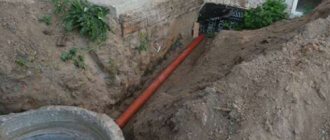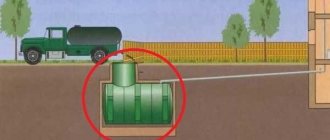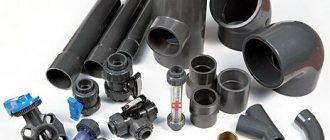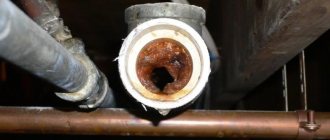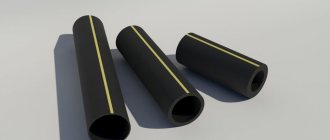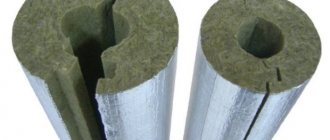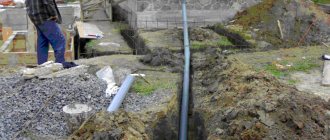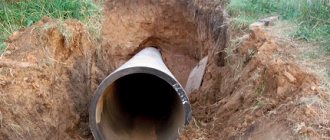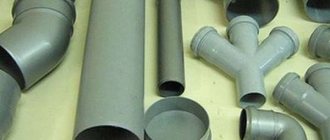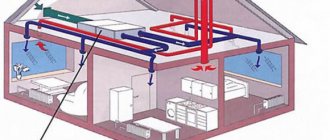For those who decide to install an external sewer system on their own, you definitely need to know the features of laying pipes in the ground, as well as the principle of selecting building materials, so our article will be very helpful.
If you are interested in the placement of the pipeline in the house, you should read the article “Laying sewer pipes”.
Selection of materials
Through the internal sewerage system, wastewater is removed from buildings and transported through an external pipeline to treatment facilities - central or local (septic tanks).
In order for your sewer system to cope with its tasks effectively, you must know how to lay sewer pipes on your site.
For the construction of an external sewer system, it is advisable to use smooth orange polymer pipes:
- polyethylene (PE);
- polypropylene (PP);
- polyvinyl chloride (PVC).
If the laying depth is significant or the sewer pipes are expected to be subject to dynamic loads (in cases where sewerage passes under pedestrian and highway roads), it is better to prefer corrugated double-layer pipes made of PE or PP.
The connection of polymer pipes occurs through shaped products - adapters, couplings, bends, etc.
Most often, external sewer pipelines are constructed from orange polymer pipes with a diameter of 110 mm.
Painting pipes orange indicates their purpose - for external sewerage; they are more durable and strong than gray products used in the construction of internal pipelines.
Pipes laid underground for external sewerage are less susceptible to corrosion, destruction and, when laid with the correct slope, do not create blockages due to the smooth structure of the inner wall. The maximum permissible depth of such pipes in the ground is 3 m.
Norms for the distance of treatment facilities on the site
According to SNiP, treatment facilities and pits must be located at a considerable distance from the house, water well and other engineering facilities.
- From a residential building - at least 5 m to a septic tank, VOC, cesspool to avoid unpleasant odors entering the room. And also prevent in advance the possible disastrous consequences of the influence of a humid environment on the foundation of the house.
- It is 30-50 m to a water well. Of course, it is very difficult to follow this rule, since the size of the plots is very limited. It is still necessary to remove the septic tank from the water supply system as much as possible, to the extent technically possible.
- To the borders of the neighboring plot - at least 2 m.
- From the collector to plants and trees - the location is 2-4 m if the tree roots are large.
Pipe laying technology
Preparing the trench
Having decided on the material, familiarize yourself with how to properly lay sewer pipes. Installation of external sewerage begins with preparing a trench, which can be dug manually with a shovel or using an excavator.
The depth of the furrows depends on the depth of soil freezing in a particular area. According to SNiP P-G.3-62, the depth of laying sewer pipes is 0.5 m less than the soil freezing mark and is approximately:
- 3 ÷ 3.5 m – in the northern regions of the Russian Federation;
- 2.5 ÷ 3 – in the middle zone;
- 1.25 ÷ 2 – on the Black Sea coast.
The indicated figures are not categorical and may vary within certain limits depending on the terrain and groundwater level. However, laying sewer pipes in the ground must be done at least 0.5 m from the surface.
When using pipes of 110 mm diameter, depressions are dug in the soil 0.6 m wide and 0.05 m deep than the depth of the pipes.
The trench has its own characteristics:
- The bottom of the trench is leveled, the necessary slope is created, as a rule, 1-2 cm for each linear meter of the pipeline.
- After leveling the bottom, it is necessary to thoroughly compact the soil and arrange a cushion of gravel or sand 10-15 cm high.
- A sand or gravel bed must be compacted in an area located 2 m before the inspection well and at the junction of the pipeline with the inlet pipe.
- Where the sockets will be located in the sewer system, pits should be formed.
Pipeline installation
Next comes the actual installation of the pipeline. It is better to start laying from the foundation of the building.
The technology for laying sewer pipes looks like this:
- The pipes are laid with the socket down in prepared trenches.
- To connect two pipes to each other, the socket of one and the smooth end of the other are cleaned of dirt.
- The joints are lubricated with special compounds.
- The pipe is inserted all the way into the socket.
- All pipeline elements must be combined in a similar way.
Pro tip: When connecting parts of a pipeline, one pipe is inserted into the socket of the next one. In order for this connection to be reliable and of high quality, it is recommended to first measure the depth to which one pipe will enter the other and make a mark in the appropriate place.
If there is an outlet in the foundation of the house, the external sewer pipe is connected to it; if it is not provided, then a hole must be made. Diamond drills are ideal for this task.
For the turning device, bends are used - 15, 30, or 450. When the length of the sewer pipeline is more than 15 m, an inspection is installed in such sections.
Backfilling the trench
After laying the pipes, the slope angle is checked. If everything is done correctly, the trench can be backfilled. For backfilling, it is allowed to use the soil formed when digging furrows, but in this case it is necessary to remove large stones from it and break up dense blocks of soil.
Advice from a professional: When backfilling, large stones and blocks of soil larger than 30 cm in size are not allowed in the soil - such inclusions can easily damage sewer pipes.
The trench is gradually backfilled to a height of 0.3 m, in layers of 5 cm. Each layer is well compacted on the sides of the pipe; compacting the area above the pipe itself is prohibited.
Laying a pipe under the base
Electricity can be supplied to the cottage from any location.
But sewerage is something else. This will not work here and you will have to resort to serious construction tasks. Steel or PVC materials are used to supply wastewater. To lay it, you should dig a ditch 2 m deep or less. Then this ditch must be brought under the supports of the house. The parameters of the ditch depend on the depth of soil freezing.
The pipeline itself must be installed under the base. For these purposes, you should punch a hole in the foundation. To ensure that everything turns out as beautifully and accurately as possible, you can use the advantages of a diamond tool. The pipe should be routed through a special casing.
Pipeline insulation
Sometimes sewer pipes need to be insulated. The need for insulation of sewer pipes arises when the pipeline is laid above the freezing depth of the soil or at the exit from the building.
In this case, stenoflex or energyflex insulation is used. Thermal insulating material is wrapped around sewer pipes along the entire length of the pipeline and securely fastened. Upon completion of installation of the insulation, the slope is checked, and only then backfilling is carried out.
The best option would be to fill the pipe with sand in a layer of 10-15 cm, which is compacted along the edges. It is allowed to fill the soil left over after digging trenches on top of the sand.
When partial repairs of an already functioning sewer pipeline are required, it is more correct and reliable to dismantle the old sewer pipes completely, and then start laying new ones.
In reality, such a solution will take much less time than replacing individual sewer elements.
Source: kanalizaciya-prosto.ru
Forming a slope for free flow
When laying the pipeline, it is necessary to provide a slope towards the septic tank. According to technological standards, the slope of a sewer pipe with a diameter of 110 mm should be 20 mm for each meter of pipeline. Pipes with a diameter of 160 mm must be laid with a slope of 8 mm per meter of laid line.
When laying pipes, the slope is calculated for one meter of pipeline. The figure shows how much the difference should be between the sides of pipes with different diameters
The presence of a slope is a determining parameter for the successful functioning of the system. The closer the pipeline performance is to the standard, the more efficient the sewage system will work.
A complete lack of slope, as well as excessive slope of the pipeline, will lead to siltation of the system. In the first case, waste will not be able to be transported through the pipes at the required speed, which will lead to the formation of blockages.
In the second, the liquid will move too quickly, which will ultimately reduce its transport capacity, and waste will remain in the pipe, which will also lead to blockages and further silting of the pipeline.
The slope of the pipeline should always be directed from the outlet of the residential building towards the septic tank. This condition is especially important when using non-pressure sewers, which are most often equipped in private households.
You can control the slope level of the entire trench using a special device - a level. If the device is not available on the farm, then the slope is checked using a building level.
Procedure:
- At the beginning and end of the pit, pins are driven in to which the cable is tied.
- A building level is applied to one end of the rope and adjustments are made to the horizon.
- The height of the trench is measured from both sides to the cable.
- Simple mathematical calculations are performed.
For example, the total length of the trench is 50 m, a pipe with a diameter of 110 mm is used. On the exit side of the house, the depth of the pit is half a meter. In this case, at the end point of the pit, its depth should be equal to one and a half meters.
Detailed technology for calculating sewer slope is described in this article.
If the site has a natural slope that exceeds the recommended standards, it is possible to lay a sewer system with several vertical transitions. In this case, on horizontal sections of the pipeline it is necessary to comply with regulatory indicators.
In areas with a large slope, the pipeline can be laid in a stepwise manner. If the slope angle slightly exceeds the standards, they are limited to one vertical transition (+)
Another option is to lay a vertical pipe at the exit from the house to a considerable depth, and then lay a pipeline from it with the required slope. In this case, the depth of the trench will be greater than when laying using the first method.
For the same purposes, you can use a drop well, into which wastewater flows smoothly to a lower level of the pipeline.
How to lay sewer pipes in a private house: step-by-step instructions
A person feels good where there are comfortable living conditions. And in order to create them, you need to think about how to lay a sewer system in a private house. Firstly, you should familiarize yourself with the features of this process, and secondly, decide on the material used.
It is worth noting that now, plastic pipes, albeit slowly, are still replacing metal pipelines. As for cast iron, they are used very rarely due to their weight and high cost. In contrast, polymer products are much lighter in weight, easier to install and durable.
External part.
What are we focusing on?
- Availability of bodies of water and their distance
- Terrain
- Depth of ground freezing
- Soil composition
- Distance of wells
Before starting work, you should develop a detailed diagram taking into account all the features. It is important not to miss anything, including ventilation. This will help avoid unpleasant odors that will begin to appear in the area over time. We will not dwell on this point in more detail, so we recommend that you separately consult with specialists or view articles on the relevant topic.
The external part of the sewer includes an internal drain outlet with a waste container.
The main stages of laying sewerage in a private house
In order for the system to function properly and no unforeseen situations arise, before laying sewer pipes in a private house , you need to competently draw up a detailed project.
It is desirable that the design of engineering systems be carried out at the time of drawing up the house project, but this is only relevant if new construction is planned.
First of all, you need to take care of the compact arrangement of water intake points, which allows you to organize the reception of wastewater into a common riser. If the kitchen and bath are located at different ends of the house, then you will have to plan to build two risers and septic tanks, which entails additional costs.
Many experts recommend that at the stage of developing a scheme for laying external and internal pipelines, one should focus on some features of the movement of wastewater through pipes. The following rules must be followed:
- The toilet must be connected to the riser separately; in addition, other devices cannot be added to the connecting pipe;
- the connection of other devices should not be at a level lower than the toilet connection;
- all plumbing, except the toilet, may have a common connection to the riser;
- the diameter of the supply pipe must be no less than the size of the drain pipe.
Once the project has been drawn up, you can proceed to such stages of system installation as choosing a location for installing a treatment plant, arranging an internal sewer network, removing it from the house and installing an external sewer system.
If you are encountering this for the first time and do not know how to lay sewer pipes in a private house, but want to do it yourself, then it is advisable not only to read the installation instructions, but also to watch the video.
Slab foundation and laying of communications
This type of foundation requires very precise calculations at the very beginning of the project.
After pouring such a foundation with errors, it will be impossible to lay the necessary communications. Therefore, a trench is dug first. All communications and sewer pipes are laid in it, dressed in special protective sleeves.
In a slab foundation, the sleeve plays a very important role. It protects the monolithic slab from high pressure and also facilitates the process of replacing a damaged section of pipe. If the sleeve is missing, it is simply impossible to replace the pipe in such a foundation. The pipe can also be damaged when the foundation is being poured.
Installation of the external part of the sewer system
Detailed instructions will help you figure out how to properly lay sewer pipes in a private house. Remember to always follow the established procedure.
It all starts with laying pipes in a trench; you need to dig it in advance. The optimal distance between the trench and the pipe should be between 200 mm and 20 cm, it all depends on the diameter. Next you need:
- Dig a hole for a septic tank or treatment well; the depth must be at least 80 cm, and most importantly, 20 cm below the freezing level of the soil.
- Taking into account local conditions, as well as the depth of installation of the sewage system, it is necessary to ensure the optimal degree of slope of the pipes.
- Compact the bottom of the trench, freeing it from large stones and solid inclusions in advance. After this, a sand cushion is created.
- Having understood how best to lay the pipeline through the foundation from where it exits from the house, the pipes are laid along their entire length.
- To connect structural elements you need to use sealant.
- For pipeline turns, a smooth bend is used.
- The external system is connected to the VOC chamber using rubber seals.
After completing all the stages, you can backfill the system; for this, not only soil is taken, but also sand. In order for the installation of external sewerage to proceed without problems, you need to take care of purchasing components (elbows, crosses, fittings, tees, transitions, plugs).
What does the system consist of?
Before talking about what and how a home sewer system is designed, you need to accurately understand its structure.
And the structure depends on where the wastewater is discharged:
- When draining wastewater outside the site (to a central or group network), the sewage system will consist of:
- internal wiring;
- release from home;
- outlet pipeline.
Connecting the house to the central sewer system
Note: if the distance from the point of connection to the foundation of the house exceeds 15 meters, an inspection (inspection) well is usually installed in the middle of the route.
- If the system is autonomous, it will also include a septic tank or a system of treatment facilities.
Note: in the second case, the design schemes can be very different, which depends on the size of the local area and the hydrogeological conditions of the site. An autonomously operating system may include treatment, pumping units, a filter (drainage) well - or, as an option, the installation of a filter field or trench.
- The sewage system of a single-family house may also be limited to simple devices for collecting feces: cesspools or backlash closets.
Option for installing an autonomous sewer system
Stages of internal sewerage installation in a private house
You don’t know how to lay sewer pipes in a private house and where to start, but if you figure it out, everything is very simple. The installation starts from the plumbing fixtures and goes to the location of the external pipe. It is better to lay it under the floor. So let's get started:
- First you need to connect the S-shaped pipe or water seal to the plumbing fixtures.
- Then the first sewage pipeline is connected.
- The horizontal pipe structure is connected to the pipe through two elbows, the angle of which is at least 90 degrees.
- Do not forget about the importance of observing the slopes of the structure, for which you need to use clamps that are attached to the walls. Thanks to them, the structure is always in its normal position.
- The pipes coming from the toilet are connected to the main elements of the sewer system, connected by a perpendicular tee.
- To ensure the passage of the pipeline through the ceiling, you need to install a metal sleeve in the insulated pipe.
- And to go from a pipe with a diameter of 5 cm to 10 cm, you will need a special adapter.
- You can equalize the external and internal sewerage using an elbow.
It will be better if you observe the slopes of the pipes; with a diameter of 5 cm it should be 3 cm, and with a diameter of 10 cm - 2 cm. In order to seal the existing pipe joints, you need to use special hermetic mixtures.
Blitz tips
- Before installing the system, work is carried out inside a private house - installation of a vertical riser to alternately supply pipes from the bathroom equipment to it, maintaining a slope of 5 mm per 1 m. When installing the pump, the slope is not necessary.
- During the planning process, the kitchen and restroom should be located near the exit of the sewer system to the street. In multi-storey construction, the arrangement of bathrooms is one below the other to reduce the number of risers and simplify the installation and maintenance of the entire network. For a large number of bathrooms or in the absence of a slope on the site, it is rational to use a pump.
Sewer outlet
Instructions on how to properly install a sewer system in a private house are not limited to a description of internal and external installation. She also describes how to properly remove pipes from your home.
You need to provide an outlet location in advance, and you also need to install several bends to connect the two parts of the pipeline.
Do not forget that you must install a metal sleeve to pass the pipes through the foundation, and insulate the space remaining between the walls of this device.
Source: kanalizaciyasam.ru
Laying sewer pipes in the ground: we equip and insulate external sewerage
Laying sewer systems in a private home does not require any complex skills, special tools or deep special knowledge. However, small errors during installation work can later lead to serious damage to the system.
The communications are subject to quite serious pressure from the soil layer; they are exposed to cold, moisture, etc. Therefore, it is necessary to ensure that the laying of sewer pipes in the ground is done correctly.
How to fill a trench
You probably think that there are no difficulties or peculiarities here? But no, it's not simple. Sewer trenches must be filled in according to special rules. These rules and regulations are regulated in SNIP.
Thus, it is possible to fill a trench only after all the necessary measurements have been completed and the readings fully correspond to the project.
You should fall asleep gradually. First, sand is poured on the side. This should be done in a small layer. Then you need to compact everything. Next, another layer is poured over the track.
They are finally filled with soil that remains from digging the ditch. To eliminate possible damage, check that there are no solid residues or frozen clods in the soil. This step must be performed in an even layer.
As you can see, the process of installing a wastewater treatment system is not that complicated. With the right amount of perseverance, the appropriate skills and tools, everything becomes possible. The main thing here is full compliance with the rules, design and safety precautions. And then everything will definitely work out.
To make a sewer system in your own home, you need to solve many related problems. The biggest difficulty is getting the pipeline out of the house. The reason is quite simple. The house always stands on a strong foundation.
It is poured to different depths, so there are several methods for removing the pipe:
- Laying a pipeline under the foundation;
- Installation through walls.
Sewer pipes are mainly laid under floors. This is due to technological necessity. Therefore, the installation of such a pipeline has to be done across the entire foundation area.
Types of sewer pipes and their features
The process of laying external sewerage looks quite simple. The pipes are laid in a dug trench, connected to the system located inside the house, as well as to the collector, and then covered with earth.
Before drawing up an external sewerage project, you need to decide on the type of pipes. The dimensions of the trench, slope, etc. depend on the diameter, cross-section and material of these elements.
Pipes that are used to create external sewage systems are distinguished by many parameters, such as diameter and cross-sectional configuration, as well as material. Today, sewer systems are made of:
- cast iron;
- ceramics;
- concrete;
- asbestos cement;
- plastic;
- fiberglass.
Cast iron pipes weigh quite a lot, their internal surface is not very smooth, and installation is very complicated, so this type of sewage system is used extremely rarely in private plots.
Ceramic elements are easier to install, but they can be easily damaged if handled carelessly. Concrete structures of large weight are also difficult to install, so they are rarely used for external sewerage in a private house.
Inexpensive and lightweight asbestos cement structures have been popular in the past, but they are somewhat fragile, and the smoothness of their internal surface leaves much to be desired.
The undisputed leader in the sewer systems market is plastic. Pipes made of PVC, PP, PVP have all the characteristics necessary for external sewerage:
- light weight;
- significant strength;
- resistance to chemicals;
- ease of installation;
- smooth inner surface;
- ability to withstand very low temperatures, etc.
Fiberglass, which is a composition of polyester resins reinforced with special fiberglass, is also very good for sewerage. However, such structures weigh significantly more and are much more expensive.
To create a sewer system on a personal plot, round plastic pipes are most often used, the diameter of which is usually 110 mm.
When laying pipes using the puncture method, for example, under the road surface, as well as in other places with high loads, it is recommended to use double-layer pipes with a corrugated outer surface.
Note! Pipes made of polyvinyl chloride (PVP) can withstand heating only up to 40 degrees, while polypropylene (PP) structures can withstand temperatures up to 80 degrees. High-strength polyethylene (HDP), which is used in the production of sewer pipes, occupies an average position in terms of heat resistance.
Waste collector
If there is no way to the central city sewer, you will have to take care of the waste disposal problem yourself. To do this, you will have to build a septic tank or drainage pit on your personal plot.
Laying sewer pipes in the ground is not the only work that is carried out outside the home. In addition, you should make a place for drainage. The simplest option is to build a pit. This is a more economical process and does not require special technologies. But you should know that the waste storage tank cannot be placed closer than five meters to the house and thirty meters from the well. Such a pit is made mainly in the far corner of the territory. The distance between sewer pipes and water supply should not be less than three meters.
The size of the drainage pit is calculated based on the residents of the house. So for each resident it is necessary to take into account about half a meter (cube). But if several people constantly live in a building, you will have to call a sewer truck several times a year.
Procedure for creating an external sewer system
The laying of sewerage pipes begins with the project. It is recommended to make a trench with a minimum number of bends; the optimal solution is a completely straight pipe without any turns.
If you can’t do without them, and the length of the system is more than 12 meters, inspection wells are installed in such places, since this is where blockages and breakdowns most often occur.
Note! Even ideally straight sewers must be equipped with inspection wells every 25 meters.
It is important to correctly determine the depth of the sewer pipe. When determining it, the depth of soil freezing and the level of the entrance of the sewer pipe into the septic tank or pipe of the centralized sewer system are taken into account.
In addition, the required sewerage slope should be ensured, which is 2 cm for each linear meter of the structure.
Often, creating a sufficiently deep trench turns out to be too labor-intensive, and sometimes impossible. In this case, it is necessary to carry out thermal insulation work to protect the drains from freezing in winter.
According to the rules for laying sewer pipes, the minimum trench width is defined as the diameter of the pipe plus 20 mm on each side for pipes.
If the pipe is wider than 200 mm, the free space should be increased, otherwise it will be difficult to correctly install the structure. Once the plan has been drawn up and all factors have been taken into account, the work begins.
To install external sewerage you should:
- Dig a trench of suitable size. Place a sand cushion approximately 50 mm thick on the bottom. Carefully compact the bottom of the trench.
- Lay and connect sewer pipes. Connect them to the internal sewerage system and to the septic tank.
- Check the operation of the system and make sure it is tight.
- Fill the space on the sides of the pipes with sand, compacting it layer by layer. Backfill the sewer from above.
Note! The layer of sand or soil laid on top of sewer pipes does not need to be compacted.
When figuring out how to properly lay sewer pipes, you should take into account the recommendations of experts:
the number of joints and turns should be minimal; all pipes must be directed towards the flow of waste; sockets and shaped elements cannot be shortened; The pipes should be secured to ensure the correct slope of the sewer.
To maintain the slope, use a marking cord that is pulled along the bottom of the trench.
Filtering fields: application features
The filtration field is a more complex engineering structure than the FC, which cannot be called compact, but it can also be used in areas with high groundwater level and a large volume of wastewater, more than a cubic meter per day. True, not every soil is suitable here; nevertheless, it must filter well. Most often, filtration fields are made in loamy soil.
The filtration field is a system of perforated pipes with a diameter of 110 mm (you can take ordinary plastic sewer pipes and make cuts in them) at a depth of at least half a meter with a slight slope.
How to create a proper filter field:
- make a cushion of crushed stone and gravel with a height of 0.2 m;
- lay pipes;
- cover again with crushed stone and gravel, the height of the layer is 10 cm above the top of the pipes;
- cover with a geomembrane;
- cover with soil.
To correctly calculate the number and length of pipes in such a sewerage scheme for a private house, you need to take into account two parameters: the volume of wastewater and the filtering properties of the soil. Pipes can be positioned in different ways, but the more branched and longer the pipeline, the better the cleaning will be.
There is a simple table that allows you to make an approximate calculation of the filtering field. It is easy to use: the top line shows the volume of the septic tank, and the type of soil in the left column. If the type of soil on the site is sandy loam, the volume of the septic tank is 5 cubic meters, then at least 5 meters of pipes are needed.
For constructing a filtration field for a household septic tank, such a table is quite sufficient.
The downside of the filtration field is that it always “bites off” a significant piece of the area, at least 30 square meters. And the biggest advantage of using this system, besides the high quality of cleaning, is durability; the filtration field silts up after approximately 10 years of service.
A few words about insulation
Insulation of sewer pipes is used quite often. For this purpose, special rolled or shaped insulation is used.
The first ones must be wound onto the pipe during the installation of the sewer system, the second ones are made for a pipe of a specific diameter and are simply put on it.
Since heat-insulating materials can lose a significant part of their useful properties when in contact with water, it is important to cover them with a reliable layer of waterproofing.
As an alternative or additional method of thermal insulation, a special heating cable is used, which is installed along the entire length of the pipe.
You can save time and effort if you buy pipes with a thermal insulation layer already installed. Elements are produced equipped not only with conventional insulation, but also with a heating cable.
When using such structures, it is necessary to carefully seal the joints so that moisture does not get on the insulation.
Source: aqua-rmnt.com
Well.
Its location is at the very bottom of the drainage system.
Its distance from objects should be different.
If we are talking about reservoirs, then the distance will be at least 10 m.
If there is a water intake well nearby, it increases to 50 m.
Now about choosing a well.
There are three types.
A sealed well called a storage well. Wastewater flows into such a container. In addition, it needs to be cleaned periodically.
Well with septic tank. A septic tank consists of several chambers sequentially attached to each other, which contain wastewater. The sediment is processed by bacteria, and then the purified liquid enters the soil.
The last type is called a deep cleaning station. That is, a well with filters. With its help, organic matter is separated, which can be used to fertilize the soil.
The first two options can be done with your own hands, but the third will require the help of a specialist, as this is a complex process. It is also possible to purchase a cleaning station.
How to lay sewer pipes - a step-by-step guide with examples
Waste water and human waste are first transported to mains located outside the building, and then end up in storage tanks or septic tanks.
To do this, you can use pipe products made from different raw materials. More recently, cast iron pipelines were used to create an external sewer line in one's own home. Today, everything has changed, and the external laying of sewerage pipes is made from polymer pipe products.
The reason was the fragility of cast iron compared to plastic, and in addition, products made from this alloy are heavy and require special equipment for installation.
Types of treatment plant.
Method one. Simplest. An elementary pit without a bottom. (If wastewater allows.) To improve filtration, it is better to use a single-chamber or two-chamber septic tank and a filter well. A more expensive option is a biofilter that supplies air.
- Single-chamber septic tank = cesspool + drainage layer.
Gravel is placed at the bottom of the well. Thanks to this, liquid particles are purified. Over time, deposits will form, then the layer should be replaced.
- Two-chamber septic tank = storage tank + filter well + overflow pipe.
This is the most popular option because it requires the least amount of cash outlay. In addition, this type is the most effective.
A two-chamber septic tank is popular for the home, as it does not require large financial costs for its equipment.
Advantages of plastic pipes
The sewer plastic pipe has a number of advantages in addition to its low weight:
- withstands the influence of active chemical environments without problems;
- it is not subject to corrosive processes;
- has a smooth inner surface, so that deposits do not accumulate on it, which lead to a decrease in pipeline capacity.
When a sewer pipe is laid in the ground, all of the above positive characteristics are of great importance, since cleaning, repairing or replacing elements of the pipeline will require excavation work.
And this leads not only to additional time, but also financial costs.
Pipe products made from plastic have the following characteristics:
- affordable price;
- does not conduct electricity, which is very important today due to the presence of many household electrical appliances in the house;
- non-toxic;
- with its help you can mount highways of various configurations.
Despite all the advantages, you won’t be able to use them if you don’t know how to properly lay sewer pipes in the ground. Among the advantages of plastic products, it should also be noted that they do not lose their original appearance over time.
When arranging a sewer system indoors with your own hands, you need to use plastic products painted gray. When laying the outer part of the structure, polymer pipes of orange, red or brick shade are used to drain wastewater and sewage.
What should you know?
When the owner decides to install a sewer system in a house, then first of all it is necessary to find out whether there is access to a centralized pipeline . If such a line runs through your village, then installing a sewerage system in this case is not very difficult. You just need to find out from the experts:
- which pipes are best suited for draining wastewater and water from the house;
- how to lay pipes correctly;
- how to properly route pipes to the collector.
The greatest difficulty when connecting to a centralized main line is laying pipes on the street. During this work, you have to dig a trench. How deep the trenches will be required largely depends on the level of soil freezing. Typically, sewerage pipes on the street are laid at a depth of 0.5-1 m .
If your house is located far from the sewer main and there is no way to connect to it, then in this case you will have to start working on installing an autonomous sewer system.
Basic provisions of sanitary norms and rules
In 1985, Sanitary Standards and Rules were approved, according to which sewer systems must be installed.
The same document contains recommendations regarding the nuances of installation work. In particular, it contains information regarding the depth of the pipeline and other important points.
The rules for laying sewer pipes indicate that their laying depth must be at least 30–50 centimeters from the soil freezing mark in each region - the calculation is carried out from the lowest point of the pipeline.
When work is carried out in areas with increased load on the soil surface (for example, under the roadway), the products should be laid deeper, sometimes at around 9 meters.
The document regulates how sewer pipes should be installed in trenches:
- In the place where it is planned to lay a sewer drain from a private household, it is imperative to compact the ground. This will prevent erosion of the engineering structure by groundwater during heavy precipitation.
- The laying of an external pipeline is considered to be correctly completed if a pipeline slope is created, which should be from 1 to 2 centimeters per linear meter. This requirement must be observed because there is no pressure pressure in domestic sewer structures.
The technology for laying sewer pipes in a trench provides that in your own home, in a place where the pipeline bends sharply, you need to equip a special well.
This allows you to make repair work easier and to replace a section of the highway that has become unusable in the shortest possible time.
There is also a rule regarding the laying of pipes for sewer structures in the ground. It states that a layer of sand at least 15 centimeters thick must be poured onto the bottom of the trench, which will ensure the stability of the system and its convenient operation.
A similar layer should be placed on top of the sewer line. The use of backfill will simplify access to the pipeline if repairs are necessary.
Experts also recommend installing inspection wells in areas where there are significant differences in the depth of pipe laying. If the length of the network is large, several of them should be installed, maintaining a gap of about 25 meters.
Undermining under a concrete foundation
If the septic tank is located close to the house (within five meters), and the thickness of the foundation does not exceed one meter, the simplest option for installing a sewer system is to create a tunnel in the place where the pipeline intersects with the base of the house.
The trench is not very deep, which reduces the complexity of such an operation.
Before starting to lay under the foundation, marking work is carried out. The point where the pipe coincides with the future sewer passage is marked.
When performing such work, the thickness of the walls, which is the reference point, must be taken into account. If this rule is not followed, the trenches may not line up. Their connection will not occur in a specific place. We'll have to start all over again. This will cause additional financial costs.
When the trench is ready, a sewer pipe is laid in it, maintaining the required slope.
If the pipeline is shallow, the sewer passage must be insulated to prevent freezing of the channel and the formation of ice. It can cause blockage of the entire space.
Backfilling of the trench is carried out carefully, in small portions of soil. Thus, the removed pipe is not allowed to move, and its slope is not allowed to change
An additional pipe is passed directly under the foundation, the diameter of which is much larger than the sewer pipe. The length of this segment is made equal to the width of the foundation of the house. It plays the role of a sleeve in which the main pipeline is laid.
This device protects the sewer system in case of unexpected subsidence of the foundation. When repair work is carried out, it is much easier to replace the damaged area.
Sequence of actions when installing a sewer system
First of all, before laying the pipes, they dig a trench. The easiest way to do this is to use special equipment, such as an excavator, or manually.
According to generally accepted technology, laying sewer pipes involves the use of pipes with a diameter of 110 millimeters. In this case, the width of the ditch should be at least 60 centimeters.
Simultaneously with increasing the cross-section of the pipe being laid, it is also necessary to expand the trench. After selecting the material, the pipe is directly laid in the trench, which has its own nuances.
Those who are interested in how to lay sewer pipes in the ground correctly should keep in mind that work must begin from the foundation of the building. If there is no pipeline for drainage from the house, a hole is cut under the base of the building and the network is supplied under it.
When there is an outlet, a socket is put on the end of the pipe leaving the building. In this case, special attention is paid to the alignment of the joined elements.
As a rule, along the entire length of the sewage and wastewater drainage pipeline there are bends and turns - they are the ones that most often cause failure of the sewer network and cause serious trouble to the owners of private houses.
It is in places where the pipeline changes its direction that various deposits begin to accumulate. Over time, they completely block the path of movement of wastewater.
Experts know how to install a sewer pipeline in a private household to prevent such troubles.
Therefore, they do not include advice from professionals, which are as follows:
- The laying of sewer pipes must be carried out using bends that have different bending angles - from 15 to 90 degrees. To provide convenient access to places where blockages form, revisions are installed above each elbow.
- After completing the formation of the outlet from the house, the pipes are placed in the trench with the sockets down and then they begin to join the products. The joining process is as follows: the edges of the products are lubricated with a special compound and they are inserted into the socket until it stops.
To correctly connect the elements of engineering communications in a private household or apartment, a simple technique is used. It consists of marking the pipes before starting work to determine the depth of their insertion into the socket. Based on them, the connection is finally made.
Types of devices for a country house
- Filtration septic tank with a compartment for settling the thick fraction. This is an advanced technology, the main operating principle of which is to separate sewage that enters the collector and divide it into fractions. As a result of passing through several filtration chambers, the liquid is purified to a state that is safe from the point of view of sanitary standards.
- Local treatment plant. In fact, these are mini-purification plants based on the use of bacteria to purify water.
- Using the container as a cesspool.
Country drainage can be separate and common
The first case is when wastewater from different plumbing fixtures enters different containers for sedimentation and filtration. In addition, separate delivery of water from street storm water collectors and the internal network is considered a separate form.
The general sewage collection and drainage system consists of laying a single pipeline both for indoor appliances and for collecting water outside.
